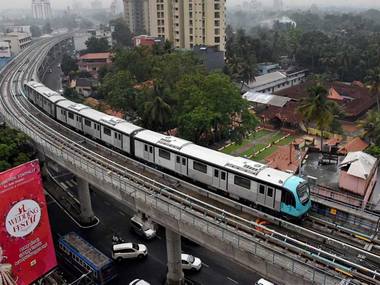When Prime Minister Narendra Modi inaugurated the Kochi Metro in mid-June, he said that 50 other cities are interested in similar rail systems. This is good news as public transportation is more sustainable than personal cars or motorbikes. It uses up less road space, consumes less fuel, emits fewer pollutants and causes fewer road fatalities. It is for this reason that the National Urban Transport Policy, adopted in 2006, recommended investments in public transport rather than in transport policies that promote greater personal vehicle use. There is a range of public transport options available, including standard metro rail systems and buses, and newer variants such as light rail, bus rapid transit and trams. Each has pros and cons in terms of costs, passenger load, environmental degradation and the ease of making route and scheduling changes in response to demand. [caption id=“attachment_3771677” align=“alignleft” width=“380”] Representational image. PTI[/caption] Metro rail systems are by far the most expensive, costing around Rs 250-300 crores per kilometre if they are elevated and more than Rs 500 crores per kilometre if they are underground. But they can transport up to 80,000 people per hour in one direction. In comparison, bus-based systems such as Bus Rapid Transport can be built at 10 percent of the cost of metro rail systems but can carry only 20 percent of what a metro rail system can. City planners should assess the number of passengers who would need to be transported before deciding on the most expensive system. If ridership levels could be accommodated perfectly well by bus rapid transport, why opt for the far more expensive metro rail? Experience from around the world has shown that many metro rail systems are carrying far fewer passengers than they are able to. The key to success with metro rail lies in designing cities that grow around the system rather than expanding peripherally, leading to urban sprawl. A metro integrated with city life would attract more passengers and make the investment worthwhile. Studies have shown that people do not like to walk more than half a kilometre to access mass transit systems. They also want safe and convenient access. The threshold of half a kilometre may increase or decrease depending on the weather and the convenience of the walking environment. These findings should be considered when designing cities to attract more people to the metro. Cities globally have enabled higher passenger ridership by setting up buses, shared taxis and feeder systems to bring people to the stations. Parking facilities allow passengers to park their motorbikes at the station and take the train. Some have opted for high-density residential and commercial developments near stations to make the system more accessible. In Singapore, many large residential areas and shopping malls are located right on top of a metro station so patrons can access the system without exiting the complex. The World Trade Center in Manhattan has a metro station below it. In India, we have a unique situation where only about a quarter of our population presently is urban and this number is expected to double in the next 30 years. This presents an opportunity to plan where people will live and work. If they could be channelled into neighbourhoods around metro rail systems, they would likely become users of mass transit. But if the newcomers choose to live in the expanding periphery of cities they would likely be too far away from the metro system and not be able to use it. City planners need to think of metro systems comprehensively. It is important to build high densities around stations so that residents become habitual public transit users. Planners should improve access to the system by putting in place a range of feeder transit: buses, shared taxis, convenient walkways, cycle tracks and park-and-ride facilities. Without these features, a metro rail system might not be worth its high building cost. Metro should be conceived as a key component of compact, low-carbon cities. They could help India achieve its laudable climate change commitments under the Paris Agreement. So, planners should conceptualise such systems as a mode of urban transformation rather than just as urban transport. The
new Metro Policy being drafted by the government should encourage such thinking. The author is CEO, World Resources Institute, India. He is a well-renowned thinker and proponent of sustainable development, urban transport, and environmental issues.
Metro rail comes with a high building cost but it can help India achieve its climate change commitments under the Paris Agreement.
Advertisement
End of Article


)

)
)
)
)
)
)
)
)



